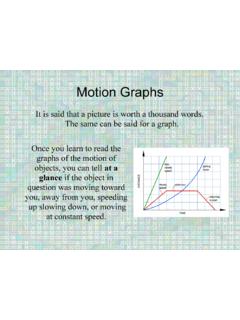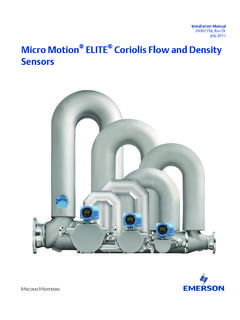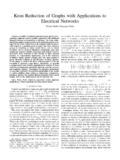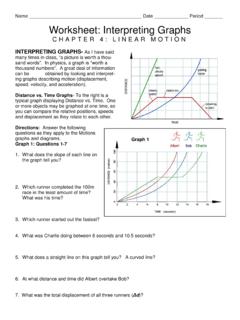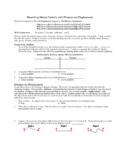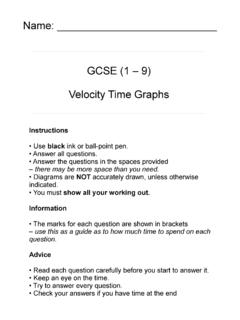Transcription of January 2018 Micro Motion F-Series Coriolis Flow and ...
1 Installation Manual20002298, Rev CFJanuary 2018 Micro Motion F-Series Coriolis Flow andDensity SensorsSafety and approval informationThis Micro Motion product complies with all applicable European directives when properly installed in accordance with theinstructions in this manual. Refer to the EU declaration of conformity for directives that apply to this product. The EU declaration ofconformity, with all applicable European directives, and the complete ATEX Installation Drawings and Instructions are available onthe internet at or through your local Micro Motion support affixed to equipment that complies with the Pressure Equipment Directive, can be found on the internet at hazardous installations in Europe, refer to standard EN 60079-14 if national standards do not informationFull product specifications can be found in the product data sheet.
2 Troubleshooting information can be found in the configurationmanual. Product data sheets and manuals are available from the Micro Motion web site at policyFollow Micro Motion procedures when returning equipment. These procedures ensure legal compliance with governmenttransportation agencies and help provide a safe working environment for Micro Motion employees. Micro Motion will not acceptyour returned equipment if you fail to follow Micro Motion procedures and forms are available on our web support site at , or by phoning the Micro Motion CustomerService Flow customer serviceEmail: Worldwide: Asia-Pacific: and South AmericaEurope and Middle EastAsia PacificUnited 240 1978 Australia800 158 727 Canada+1 303-527-5200 The Netherlands+31 (0) 704 136 666 New Zealand099 128 804 Mexico+41 (0) 41 7686 111 France0800 917 901 India800 440 1468 Argentina+54 11 4837 7000 Germany0800 182 5347 Pakistan888 550 2682 Brazil+55 15 3413 8000 Italy8008 77334 China+86 21 2892 9000 Central & Eastern+41 (0) 41 7686 111 Japan+81 3 5769 6803 Russia/CIS+7 495 981 9811 South Korea+82 2 3438 4600 Egypt0800 000 0015 Singapore+65 6 777 8211 Oman800 70101 Thailand001 800 441 6426 Qatar431 0044 Malaysia800 814 008 Kuwait663 299 01 South Africa800 991 390 Saudi Arabia800 844 9564 UAE800 0444 0684 ContentsChapter 1 Planning.
3 Checklist .. practices .. limits ..3 Chapter 2 Mounting .. the sensor .. extended electronics ..6 Chapter 3 Wiring .. for wiring .. 4-wire cable .. the 9-wire cable ..13 Chapter 4 Grounding ..14 Chapter 5 Supplementary information .. the sensor case .. relief ..16 ContentsInstallation Manual iContentsiiMicro Motion F-Series1 PlanningTopics covered in this chapter: Installation checklist Best practices Temperature checklist Make sure that the hazardous area specified on the approval tag is suitable for theenvironment in which the meter will be installed. Verify that the local ambient and process temperatures are within the limits of themeter. If your sensor has an integral transmitter, no wiring is required between the sensorand transmitter.
4 Follow the wiring instructions in the transmitter installation manualfor signal and power wiring. If your transmitter has remote-mounted electronics, follow the instructions in thismanual for wiring between the sensor and the transmitter, and then follow theinstructions in the transmitter installation manual for power and signal cable lengthsTable 1-1: Cable typeTo transmitterMaximum lengthMicro Motion 9-wire9739 MVD transmitter1000 ft (300 m)All other MVD transmit-ters60 ft (20 m) Micro Motion 4-wireAll 4-wire MVD transmit-ters- 1000 ft (300 m) without Ex-approval- 500 ft (150 m) with IIC rated sensors- 1000 ft (300 m) with IIB rated sensorsMaximum lengths for user-supplied 4-wire cableTable 1-2: Wire functionWire sizeMaximum lengthPower (VDC)22 AWG (0,35 mm2)300 ft (90 m)20 AWG (0,5 mm2)500 ft (150 m)18 AWG (0,8 mm2)1000 ft (300 m)Signal (RS-485)22 AWG (0,35 mm2) or larger1000 ft (300 m) For optimal performance, install the sensor in the preferred orientation.
5 The sensorwill work in any orientation as long as the flow tubes remain full of process Manual 1 Preferred sensor orientationTable 1-3: LiquidsGasesSlurries and self-draining applica-tions Install the meter so that the flow direction arrow on the sensor case matches theactual forward flow of the process. (Flow direction is also software-selectable.) practicesThe following information can help you get the most from your sensor. There are no pipe run requirements for Micro Motion sensors. Straight runs of pipeupstream or downstream are unnecessary. If the sensor is installed in a vertical pipeline, liquids and slurries should flow upwardthrough the sensor. Gases should flow downward. Keep the sensor tubes full of process fluid. For halting flow through the sensor with a single valve, install the valve downstreamfrom the sensor.
6 Minimize bending and torsional stress on the meter. Do not use the meter to alignmisaligned piping. The sensor does not require external supports. The flanges will support the sensor inany Motion limitsSensors can be used in the process and ambient temperature ranges shown in thetemperature limit graphs. For the purposes of selecting electronics options, temperaturelimit graphs should be used only as a general guide. If your process conditions are close tothe gray area, consult with your Micro Motion In all cases, the electronics cannot be operated where the ambient temperature isbelow 40 F ( 40 C) or above +140 F (+60 C). If a sensor is to be used where the ambienttemperature is outside of the range permissible for the electronics, the electronics must beremotely located where the ambient temperature is within the permissible range, asindicated by the shaded areas of the temperature limit graphs.
7 Temperature limits may be further restricted by hazardous area approvals. Refer to thehazardous area approvals documentation shipped with the sensor or available from the MicroMotion web site ( ). The extended-mount electronics option allows the sensor case to be insulated withoutcovering the transmitter, core processor, or junction box, but does not affect temperatureratings. When insulating the sensor case at elevated process temperatures (above 140 F),please ensure electronics are not enclosed in insulation as this may lead to electronics failure. For all F300 sensors, the difference between the process fluid temperature and the averagetemperature of the case must be less than 120 F (66 C).Ambient and process temperature limits for standard-temperature models: 316 Lstainless steel (S), nickel alloy C22 (H), and high pressure (P)140 (60) 40 ( 40)81 (27) 148 ( 100) 148( 100)400(204)140 (60)ABBTambTprocTamb = Ambient temperature F ( C)Tproc = Process temperature F ( C)A = All available electronic optionsB = Remote mount electronics onlyPlanningInstallation Manual 3 Ambient and process temperature limits for high-temperature models: 316L stainlesssteel (A), nickel alloy C22 (B)-40 (-40)-148 (-100)TambTprocAB140 (60)-40(-40)Tamb = Ambient temperature F ( C)Tproc = Process temperature F ( C)A = All available electronic optionsB = Remote mount electronics onlyPlanning4 Micro Motion F-Series2 MountingTopics covered in this chapter.
8 Mount the sensor Attach extended the sensorUse your common practices to minimize torque and bending load on process reduce the risk of condensation problems, do not orient transmitters or sensor junction boxeswith their conduit openings pointing !Do not lift the sensor by the electronics or purge connections. Lifting the sensor by theelectronics or purge connections can damage the the sensorFigure 2-1: Notes Do not use the sensor to support the piping. The sensor does not require external supports. The flanges will support the sensor in Manual extended electronicsIf your installation has a sensor with extended electronics, you will need to install theextender onto the sensor core processors are matched at the factory to specific sensors. Keep each core processortogether with the sensor with which it was !
9 Keep the extender and feedthrough clean and dry. Moisture or debris in the extender orfeedthrough can damage electronics and result in measurement error or flowmeter Remove and recycle the plastic cap from the feedthrough on the and extender componentsFigure 2-2: GHEDCABFA. Transmitter or core processorB. ExtenderC. O-ringD. FeedthroughE. Clamping ringF. Clamping screwG. Plastic plugH. Plastic capMounting6 Micro Motion F-Series2. Loosen the clamping screw and remove the clamping ring. Leave the O-ring in placeon the Remove and recycle the plastic plug from the Fit the extender onto the feedthrough by carefully aligning the notches on thebottom of the extender with the notches on the Close the clamping ring and tighten the clamping screw to 13 18 in-lbs.
10 (1,5 2 N-m).MountingInstallation Manual 73 WiringTopics covered in this chapter: Options for wiring Connect 4-wire cable Connect the 9-wire for wiringThe wiring procedure you follow depends on which electronics option you procedures by electronics optionTable 3-1: Electronics optionWiring procedureIntegral transmitterThe transmitter is already connected to the sensor. No wiring isrequired between sensor and transmitter. See the transmitter in-stallation manual for wiring the power and signal cable to electronicsThe electronics are separated from the sensor by an extenderand must be attached as described in Section There is no wir-ing required because the physical connection includes the elec-trical Direct Connect There is no transmitter to wire.










